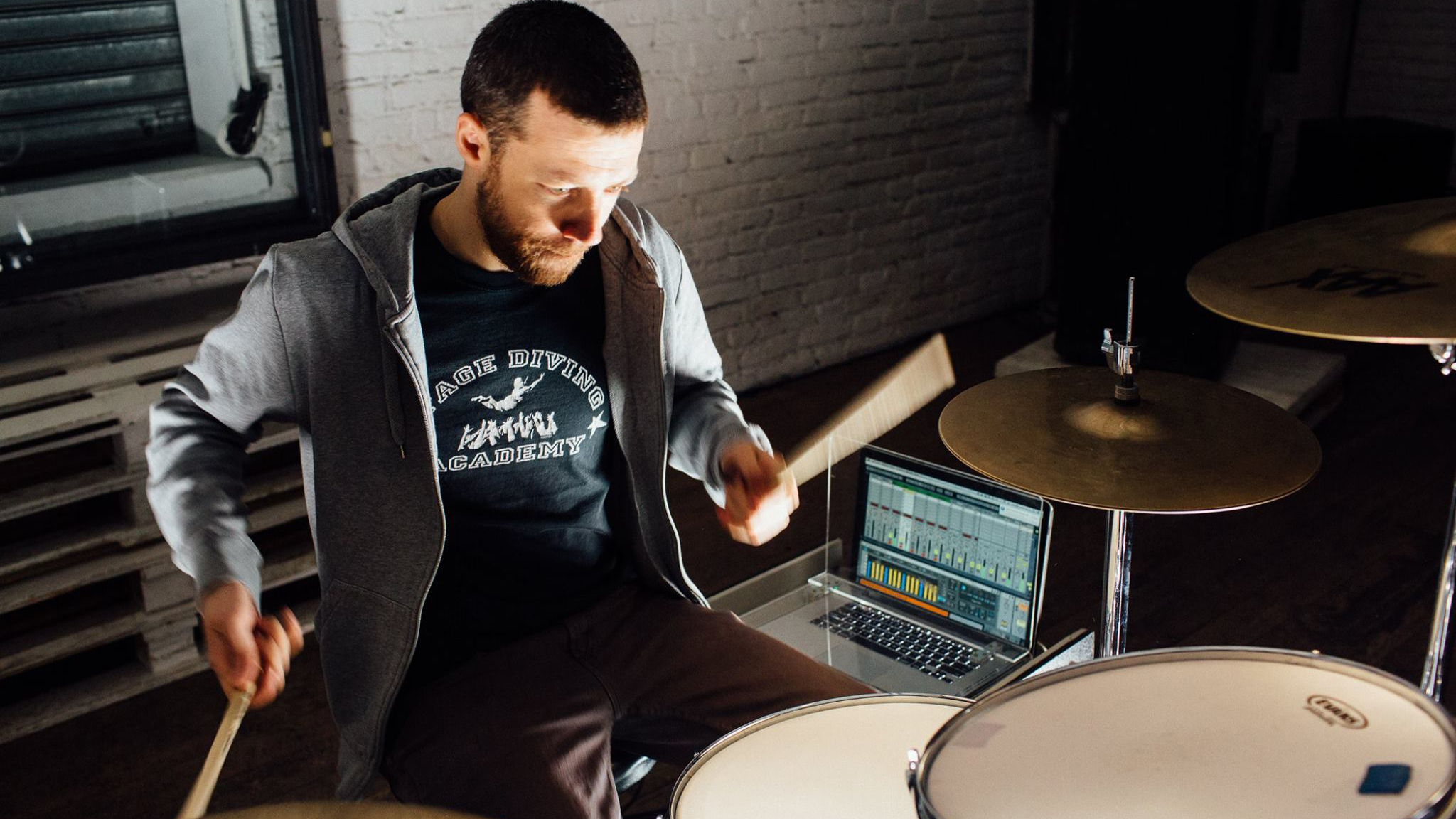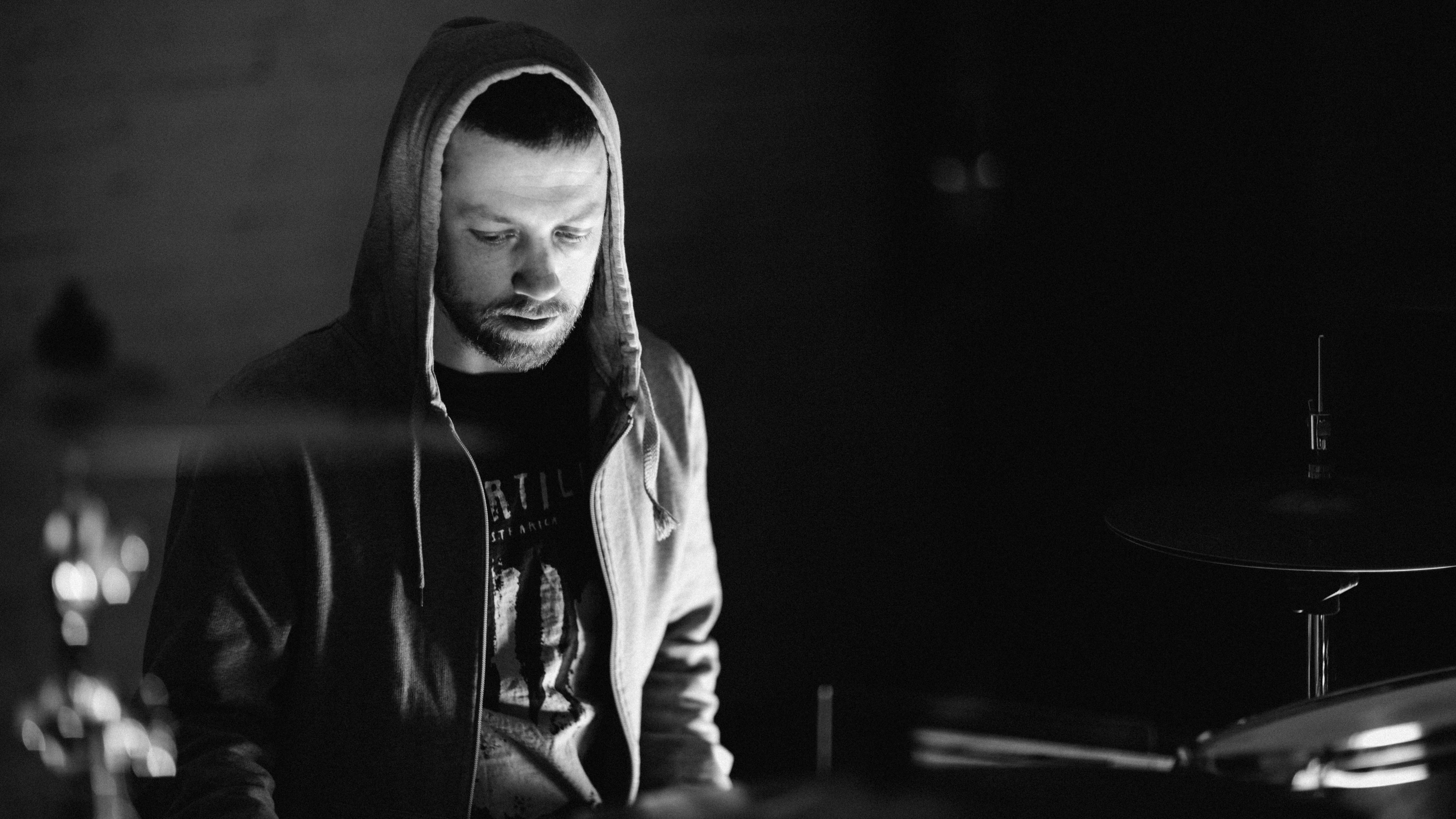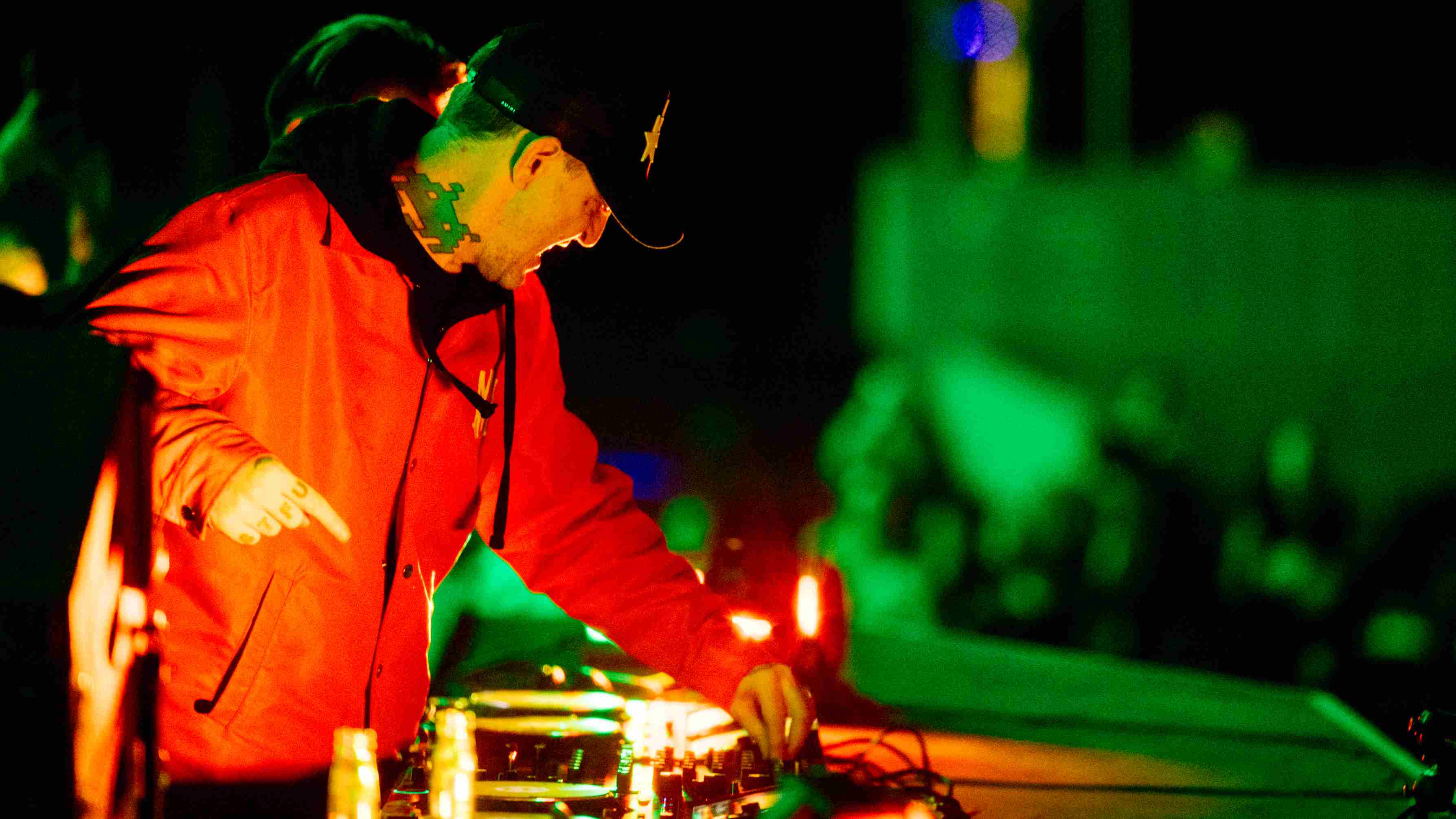Introducing: KHOMPA
Live drums meet real-time triggering with Davide Compagnoni’s groundbreaking drum-led project

Mention the phrase ‘Drummer’s solo album’ to most musos and you’ll be met with a blank expression, or accusations of note-heavy fusion. However, armed with samples, a copy of Ableton Live and a host of ideas, drummer Davide Compagnoni’s solo project, Kompah pushes the boundaries of what is possible from behind a drum kit.
By utilising technology, Davide was able to record and perform the music from his debut album The Shape Of Drums to come (a tip of the hat to Swedish hardcore heroes, Refused), and while many drummers are used to performing using loops and samples, Davide’s approach - incorporating a custom step sequencer for Ableton - sees him playing the musical phrases in real time: no loops here.
With new single Religion and a new set of material in the works, we catch up with Davide to find out exactly how his setup works.
Your album ‘The Shape Of Drums To Come’ has been written entirely around triggering and playing melodic phrases directly from your kit - how did the project come about?
I started playing drums about 20 years ago but I don't think I've ever been just a "drummer" (with much respect for all the drummers though!). First of all, I've always been a musician and a great music lover. I have always experimented with loopers, samplers, pads, triggers, etc., as I always had the instinct to add something more to the classic drum set approach, something more than just percussive sounds, more melodic. As a multi-instrumentalist (I studied piano, guitar, etc.), I always knew that at some point I would have done a solo record. I’ve always felt that need. Making music for me is a sort of a need. Obviously at that time I didn't know yet that I would have done it with this method. I was imaging myself recording all the various instruments separately, as a musician who makes a record on his own usually does. When I came across Maxforlive I realized that everything was possible. So, thanks to the help of a sound designer friend, I started working on my own Max patch, that is now the core of my solo project KHOMPA. It is a very sophisticated step sequencer, specifically designed to make melodies through drum triggers. In the meantime, I tried several drum triggers on the market, worked on latency issues, trying different drum triggers, audio interfaces, midi interfaces, etc. In the end I found my setup and I finally wrote my first solo record “The Shape of Drums to Come” that was released by the mighty London label Monotreme Records (65daysofstatic, This will Destroy You, etc.).
You’re using your own step sequencer via Max for Ableton Live, please tell us about how that developed.
My patch is a constantly-changing monster. It is the beauty of Max, you can develop your own music instruments/devices and keep on adding new features when you need it. I started programming KHOMPA step sequencer with a skillful sound designer from Torino. We spent countless sleepless nights programming and testing the patch.
Get the MusicRadar Newsletter
Want all the hottest music and gear news, reviews, deals, features and more, direct to your inbox? Sign up here.
We started from an already-existing Max for Live object (a step sequencer) and we further developed it as per my musical needs. This step sequencer allows me to control virtual instruments (synths and samplers in Ableton Live) through the midi notes generated by the triggers installed on my drum kit. Every time I hit a drum, the step sequencer shifts to the next step/note, in this way I can do melodies without the use of any backing track or loop. 100% live.
The step sequencer is divided into 16 patterns, each pattern can have from 1 to 64 notes. To change from one pattern to the following one, I use a custom pedal which works exactly like a trigger (sending a midi note to the step sequencer every time I press it). Regarding specific features, for each note you can decide whether it should be a "continuous" note (playing until the next note is triggered, just like the NOTE ON feature that many synthesizers have) or decide a fixed length for that specific note; and obviously you can set the velocity for every single note.
In addition, you can set the sensitivity of the step sequencer using the threshold feature (just like in common drum brains for using triggers), you can decide to totally bypass the step sequencer whenever needed (so that it will not react to the midi notes sent from the triggers, letting me play drums without generating any electronic sound), etc.
The step sequencer is also full of utility features that are useful during the composing/creative process; features like copying and pasting a pattern, deleting patterns, etc.
I am currently working on a new record and I’ve just added some new features, also optimising the overall performance of the patch in terms of calculating power. It is now more stable and efficient in terms of CPU usage.

Does it change the nature of the way you write, considering you’re stepping through notes on a sequencer rather than triggering phrases in increments of a bar or more?
Yes, it is definitely a different writing method. It is not like writing a song totally in your laptop using your daw’s sequencer or, for example, triggering entire loops with increments of a bar or more. This is a more live approach, where basically every single hit corresponds to a note. So when you hit a drum you generate a note, when you don’t hit a drum, there is no sound coming out of the daw. I didn’t use any loop or didn’t trigger entire phrases from one single hit. It is a challenging and inspiring process.
Most of the songs were born from improvisation sessions in which I played the drums and recorded (in Ableton Live) the MIDI signals generated by the triggers. I often started playing the drums with a single note (usually a bass synth) on the bass drum and, once I found an interesting groove, I began to sing a melody in my head. I stopped, wrote the melody in the step sequencer and started playing again triggering the melody in the step sequencer, and so on. In other cases, I focused on the rhythmic aspect, always recording the MIDI signals in Ableton Live. Then I went home and wrote melodies using the step sequencer as a kind of post-production tool. Once I found some interesting atmospheres, I returned to the studio and arranged the song.
Many drummers use sample pads and triggers/modules to add electronics to their sound, but Ableton is becoming increasingly popular, why do you think this is?
I think Ableton is so popular because it is a super versatile DAW. It is designed to play music live, which is exactly what a drummer needs, whether you need to trigger samples or entire loops, or if you need to work with backing tracks in more standard band contexts. I use Ableton for my solo project KHOMPA but I also use it when I find myself working as a session musician, for backing tracks, click tracks, band cues, etc.
I think it is the most versatile daw on the market and I am so happy to be part of the family, being an official Ableton artist. Then, if you add the fact the Maxforlive is integrated in Ableton Live, you have a daw that has no limits and this is totally perfect for us drum nerds.
What would be your advice for drummers looking to get started with using Ableton - there are so many ways of approaching the software, where should someone start for basic triggering of loops and samples?
This is a tough question because the possibilities are endless. I think the first thing you need to do at the beginning is to be patient. Working with drum triggers can be difficult at the beginning. Depending on the way you hit your drums, depending on the way your drum kit is designed and several other factors, you can encounter problems like cross talks, threshold problems, dynamics issues, etc.
Probably the first thing you need to do is to set thresholds, whether with your drum brain or through Ableton devices (e.g. the Ableton MIDIi device called “Velocity”).
You need to find your way to do it and I think that if you use Ableton you are doing the right thing because it is a very customizable tool. You just need to really dig into it and the cool thing is that you have lots of resources on the Web to learn how to solve problems.
I can see that the Ableton drummer community is growing fast since the day I started my solo project KHOMPA. There is also a super cool website which is all about sharing information, tutorials, networking for drummers using Ableton Live. It is run by a German guy who is also into Maxforlive and is constantly sharing new patches and useful tools for Ableton drummers. That’s a very useful resource.
Please talk us through your setup and how the audio/midi chain works from your kit to the computer…
I am in the middle of a big change in my setup as I am working on a new record. My original chain was: 3 drum triggers (kick, snare, floor tom) + Roland BT-1 bar trigger pad > Yamaha DTX Express drum brain > RME Fireface UCX audio interface > Macbook Pro, Retina, 2,7 Ghz Intel Core i7, 16 gb RAM. For live gigs with my light setup (8 led bars + 1 strobo), I connect my main laptop to a second laptop (running Resolume software) through an Ethernet hub.
My new chain has changed because I have recently become a Sensory Percussion artist. This company is really changing the game in the drum triggering industry. This sensors work as a condenser microphone and therefore they need a phantom power to be activated. So I am not using a midi brain anymore, which is actually substituted by the Sensory Percussion software in my laptop. Instead I use just a single audio interface with 4 mic preamps (with phantom power). It is a very cheap interface from Beringher with Midas pre-amps. Drivers are super stable and the interface is working great for me so far. I am also using a new drum pad called BopPad by Keith McMillen Instruments. It is a new concept of drum pad, very lightweight and super sensitive.
So my new chain is: 3x SP drum sensors > Beringher UMC404HD > Macbook Pro, Retina, 2,7 Ghz Intel Core i7, 16 gb RAM. The BopPad is going straight into the laptop via USB (you can also use it via a midi box that is sold separately).
This new chain allows me to have a lighter setup, more suitable for flying gigs too. And the Sensory Percussion sensors are just out of this world, but I would need another whole interview to explain exactly how they work!
People may be surprised to find that you only have three triggers within your kit, how do you get so much mileage out of these?
I think that the combination of drum triggers with my custom step sequencer (plus a lot of work!) allows me to do basically whatever I want. It is, again, a matter of patience, inspiration and musical ideas that can fit this kind of musical approach. You can’t do anything, you are not a band. You definitely have some limits. But if you find the right way to use this kind of setup, you can really produce some great music with it.
What is your acoustic kit setup?
My main choice in terms of drum kits has always been Ds Drums, and I am lucky enough to be an endorser since forever. These are top quality drums handcrafted in Italy. The all-maple kit I’ve used for The Shape Of Drums TO Come is: 24” bass drum, 13” tom, 18” floor tom, 14” snare drum. For my new record I am using the following setup: 20” bass drum (maple), 16” floor tom (maple), 13” snare drum (steel) Regarding cymbals, I always change brand and sizes depending on the current needs and depending on the fact that I often break them.
You’ve performed the album live since its release, what’s next for KHOMPA?
I played in several Italian clubs and festivals. The audience response was great, it was super satisfying to see that after all this work. I am currently working on a new record that is going to be quite different from the last one, it is more electronic oriented, with a less rock attitude. Can’t wait to finish it and start a new chapter of this crazy solo project called KHOMPA. I am also working on a new visual setup for live gigs. More info soon on my social media accounts.

I'm a freelance member of the MusicRadar team, specialising in drum news, interviews and reviews. I formerly edited Rhythm and Total Guitar here in the UK and have been playing drums for more than 25 years (my arms are very tired). When I'm not working on the site, I can be found on my electronic kit at home, or gigging and depping in function bands and the odd original project.
Zak Starkey is back in The Who. “I take responsibility for some of the confusion… Zak made a few mistakes and he has apologised”, says Pete Townshend
“I oversaw every element - not just the music and the lyrics and the melodies and the production, but also the merch and the fan clubs and everything”: Mike Portnoy talks about his years away from Dream Theater









